EVM-compatible chain: What it is and why it matters for DeFi and crypto
When you hear EVM-compatible chain, a blockchain that can run the same code as Ethereum, enabling apps and wallets to work across multiple networks without changes. Also known as Ethereum-compatible chain, it’s what lets you use MetaMask on Polygon, Arbitrum, or BNB Smart Chain just like you would on Ethereum itself. This isn’t just tech jargon — it’s why you can swap tokens, stake crypto, or mint NFTs without waiting for Ethereum’s slow, expensive transactions.
Most EVM-compatible chains are built to copy Ethereum’s core rules but fix its biggest problems: high fees and slow speeds. BNB Smart Chain, a fast, low-cost blockchain from Binance that runs EVM code and hosts hundreds of DeFi apps is one of the most popular. Polygon, a layer-2 scaling solution that connects to Ethereum for security but handles transactions off-chain for speed lets you trade tokens for pennies. And Arbitrum, an Ethereum sidechain that uses optimistic rollups to cut costs while keeping Ethereum’s security is where big DeFi projects like Uniswap moved to avoid Ethereum’s congestion.
These chains aren’t just backups — they’re the main stage for DeFi today. Over 80% of new DeFi activity happens on EVM-compatible networks, not Ethereum mainnet. That’s why you see so many airdrops on BNB Smart Chain or token listings on Polygon. It’s also why scams like fake exchanges (IslandSwap, Libre Swap) and abandoned tokens (EzyStayz, Apple Network) show up here — they’re targeting the same users who trade on these chains because they’re easy to join and cheap to use.
If you’re using MetaMask, buying tokens on PancakeSwap, or claiming an airdrop from Pera Finance or HeroesTD, you’re already on an EVM-compatible chain. You don’t need to understand the code behind it — just know that these networks let you move fast, spend less, and access more apps than Ethereum alone ever could. But with speed comes risk: not all chains are secure, and not every project on them is real. That’s why the posts below cover exactly what you need to know — from verified platforms like Mercado Bitcoin and BC Bitcoin, to red flags on sketchy exchanges and abandoned tokens. You’ll find real tools, real warnings, and real choices — no fluff, no hype, just what works in 2025.




